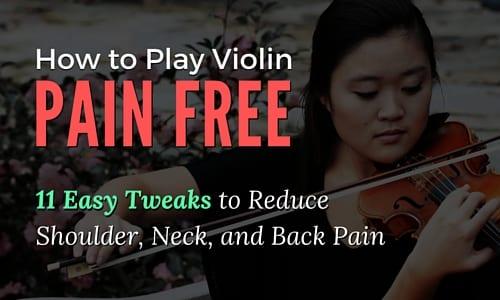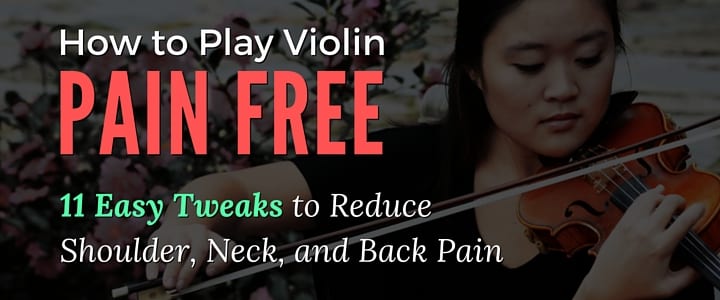Do you experience pain or discomfort when you play violin? Here, Portland, OR violin instructor Naomi Cherie S. shares her tips to teach you how to play violin pain free…
If you’ve been playing violin for a while, you know that it can be a lot of fun! You’ve probably also noticed, however, that it isn’t always the most comfortable instrument to play. Due to the positions and poses necessary to play this unusual instrument, you may feel sore and stiff after practice.
Like most physical activities, any repetitive motion can cause wear on the body. Over time, these issues can develop into bigger problems.
Just like athletes, we musicians must take the time and consideration to keep up with maintenance and do preventative exercises to keep our bodies in peak playing shape!
We’ve put together a list of 11 quick fixes and healthy practice habits to help you learn how to play violin pain free!
Wear Comfortable Shoes
You may play violin with your hands and arms but this doesn’t mean you should forget about your feet!
If you’ve ever been on your feet all day, for a job or at school, you know it’s important to have proper footwear. The same applies for violin.
Wear comfortable shoes when you practice. Cushioned flats or tennis shoes will give you the support you need and take some of the pressure of standing off your lower back.
Use a Pad or Cushioned Rug for Practice
I always recommend that my students set up a designated practice area in their house to get inspired to practice regularly. Set up a corner in your bedroom, study, or living room where you keep your music stand and violin.
Make sure to keep a cushioned rug or floor mat in your area to stand on, especially if the room has bare floors. This will also help take stress off of your lower back.
If you’re still having issues, try investing in a memory foam floor mat.
Use a Comfortable Chair With a Pillow or Cushion
Many people prefer to stand when they play, to practice presentation and posture. If you get stiff when you play, however, don’t rule out sitting during practice.
You may also want to alternate between sitting and standing every few minutes. When you sit down, make sure to use a proper chair like a desk chair or dining room table chair.
Avoid using something with too much cushion, like a recliner or couch. Make sure to sit up tall on the edge of your chair with your spine straight. Your legs should make a right angle and your feet should rest flat on the floor.
If your chair becomes uncomfortable, keep a flat cushion or memory foam pad nearby.
Pace Yourself
It’s very important to pace yourself, especially as a beginner. You want to achieve consistency but you need to be careful not to overdo it, which can cause burnout and physical strain.
You need to develop the necessary muscles and flexibility required to play the violin. As a beginner, your body isn’t used to the unusual poses required to play the instrument.
Practice daily in segments, rather than extended periods once or twice a week. Beginners should start out with 20- to 30-minute practice sessions. After a few months, you can increase your practice time to 3o minutes to an hour.
This practice time will increase as your playing stamina develops, and as time goes on, you’ll get a feel for how much practice you need to accomplish your goals.
Take Stretch Breaks
Stretch breaks are incredibly important. It’s easy to get carried away and play for long periods of time; make sure to stop and stretch every so often.
You can take breaks in between scales, exercises, or songs. Put your instrument down, shake out your hands and arms, and stretch your wrists. Don’t forget to also stretch your legs, and your neck and shoulders.
These simple stretches can prevent strain, injury, and bigger issues down the road.
Reduce Tension: Breathe and Relax
Breathe. It sounds like a simple concept, but when you’re wrapped up in the passion and energy of music or concentrating on a difficult concept, it’s easy to forget to breathe consistently.
Keep a reminder in the back of your head and allow yourself to breathe throughout the practice session. Be mindful about tension. Your neck and shoulder muscles may tense up during practice, so take note of this and remember to relax.
Sometimes we don’t realize we’re tensing up, so take a breather every few minutes to keep yourself in check!
Try these five exercises to reduce tension when you play violin.
Proper Posture
When it comes to playing violin, proper posture is imperative! Whether you’re standing or sitting, your spine must be tall and straight at all times.
While standing, keep your feet about a foot apart with equal weight on each foot. Keep your tummy tucked to avoid putting pressure on your lower back.
While seated, keep your feet spaced about a foot apart with each foot flat on the floor.
Proper Stand Height
The proper stand height (or owning a stand at all) is important to develop healthy practice habits.
Some beginners overlook this detail and try to practice their sheet music by hunching over and reading it off a couch arm, desk, or table. Avoid this mistake and purchase a music stand.
Not only is it important to have a music stand, it also needs to be the correct height. Many of the generic stands sold in stores are made for children and don’t get much higher than five feet. If you’re an adult or you’re taller than five feet, make sure you invest in a stand that has an extension rod that allows you to adjust your stand. You may need to visit a violin shop or order a stand online.
When you’re looking at your music, it should be eye level. You shouldn’t need to bend your neck to read your music. You can reduce tension by keeping your head level and your spine straight.
Besides a music stand, find out which violin accessories you may need!
Exercise Daily
Regular exercise is important to alleviate the aches and pains from playing violin, but it’s also important to relieve the aches and pains of life!
In addition to your stretch breaks, make sure you stretch before and after practice. Pre-practice stretching is a great addition to your practice routine. Post-practice yoga is one of my favorite ways to stretch my back and neck after a long playing session.
Keep a yoga mat near your practice area and consider picking up a few poses from a YouTube yoga channel. Trust me, your body and your mind will thank you for it!
In addition to physical exercise, don’t forget to do exercises to build your finger strength!
Strengthen Your Core
A strong core will reduce the tension on your upper back, shoulders, and neck. When you have a strong core and abdomen, you can absorb some of the pressure the violin causes to your upper body.
Try adding core-strengthening exercises like crunches, push-ups, or light weight lifting to your daily exercise routine to help you build a strong core foundation.
Massage Therapy
If you’re like me and you’re prone to back and neck issues (due to genetics or previous injuries), you may still deal with back, neck, or shoulder pain from time to time, even with healthy practice habits.
For more serious cases, it may be necessary to seek professional help from a massage therapist, acupuncturist, chiropractor, or physical therapist. I’ve personally employed the assistance of many professionals over the years, and combined with lifestyle choices and healthy practice habits, I’ve found some relief.
When dealing with a more serious issue, sometimes it’s necessary to take some time off from playing violin. Recognizing the problem and taking time off to heal will make playing violin much more enjoyable.
Use these tips when you practice violin to develop healthy habits, increase longevity, and reduce pain.
If you have questions, let us know in the comments below!
 Post Author: Naomi Cherie S.
Post Author: Naomi Cherie S.Naomi teaches violin in Portland, OR. She is a classically trained violinist with over 20 years of experience and a diverse musical background. Learn more about Naomi here.
Photo by _zhang (with text overlay)
Maile Proctor


